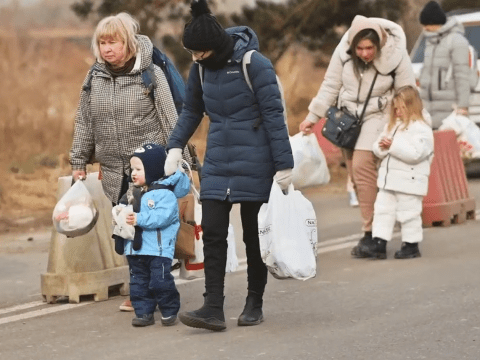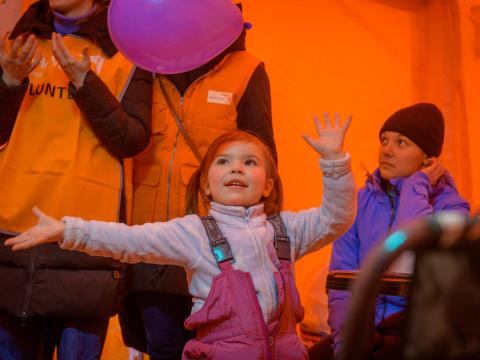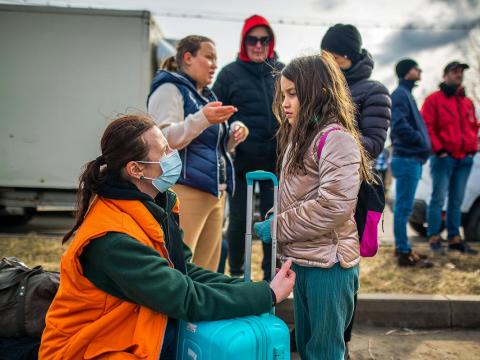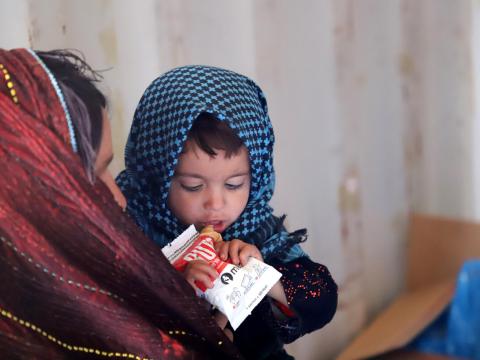
Crossing borders with Ukrainian refugees
Patricio Cuevas-Parra reflects on joining a line of Ukrainian refugees as they fled the conflict in their country and entered Poland.
While the armed conflict continues in Ukraine, more than half of Ukraine’s children, and almost 12 million people overall, have been forced to flee their homes and seek safety inside and outside the country. At the beginning of this conflict in early March, I visited the Ukrainian city of Lviv as part of my work with the World Vision response team. I went to assess the ongoing displacement situation and meet potential partners we could work with in response to this enormous humanitarian crisis. Even though there had not yet been any attacks on Lviv, a sense of fear was all over the city, with local citizens prepared to flee in the case of an attack.
When we finished our assessments and were headed back to Poland; suddenly and abruptly, we were part of a flow of around two hundred Ukrainian refugees. They were desperately trying to reach Poland, having left their houses, businesses, relatives and belongings behind to escape from the war. I had seen images of long lines of refugees crossing borders to flee turmoil in Iraq or Syria on TV and in newspapers many times but being caught up in one was absolutely surreal. I was crossing the borders together with the refugees, step by step, breath by breath; as the line crawled closer to the Polish border.
It was an extremely emotional and painful experience. I could sense the agony, anguish, fears, and also a kind of hope throughout the 300 metres that separates the borders. Almost all of the refugees crossing with us were women, children, and the elderly; with only a few exceptions men are banned from leaving Ukraine. My heart was broken as I saw many children looking disoriented, not fully understanding how their lives had changed so dramatically in just a few days. Mothers were trying to pull themselves together while comforting their children. Burying their tears and despair deep inside, saying goodbye to their roots and walking towards an uncertain future. Elders who could not walk well were supporting each other, and carrying plastic bags containing only what things they could manage.
The grief and mourning that each and every one carried on their shoulders was visible. As I walked alongside them I felt how utterly unfair life was: we were crossing the same boarder, but my situation was entirely different. I hold a passport that allows me to travel almost everywhere, I had a hotel reservation waiting for me in Poland, and once my deployment finished, I would fly safely back to my home base. They were marching into the unknown and faced having to process profound feelings of loss, whether of a loved one, of a homeland, of social status, of well-being, of a future.
These refugees are on a journey they haven’t chosen, most of them do not have enough economic resources to pay for a place to stay or eat. Above all, they have lost almost everything in their mother country. Most of them were asking themselves: where to go? Where to start a life? When can we go back to our town? How many of our relatives that stayed behind will survive?
We have all experienced grief in our lives, and most probably, we have gradually overcome it. Still, when a situation that caused our grief is unresolved or prolonged, like a war, it is challenging to reach the last stage of grieving when we can move on and build a new life without the deep sense of loss.
When organisations like World Vision respond to refugee crises, we don’t just address the basic needs of refugees and displaced people. It is critical to look at the intersection between the psychosocial damage produced by the war, the throbbing wound of the migration or evacuation process, and their struggles to adjust to a new life in the host community. Many displaced people will have directly experienced persecution, famine, and poverty; they will have witnessed violence or been direct victims of violence or abuse. Many of the children I saw were travelling without any relatives who could protect them, or in some cases, they did have adult carers with them, but they were so highly traumatised that they were unable to take care of themselves.
Mental health and psychosocial support should be considered a core component of all humanitarian interventions, especially at the border crossing points, shelters for internally displaced people and reception centres. Even though most refugees can reach safety in the host communities, the psychological impact of the war, violence, and separation from the loved ones may continue for a long time. Children and young people need to be supported with the tools to understand and deal with these painful experiences. This goes along with education, livelihood, protection, and health strategies.
As a professional and an individual, I am still processing this unbearable journey that I shared with these two hundred refugees. I’m now back in my home and office, but I can't forget each face and the feelings I sensed that day. As the number of refugees hits 5 million, we must never overlook the human dimension of this humanitarian catastrophe, especially the most vulnerable.
Patricio Cuevas-Parra is the Director of Child Participation and Rights at World Vision International. He was recently seconded to the organisation’s Ukraine Crisis Response as the Child Protection Lead, and spent several weeks based out of Poland, conducting assessments there. Follow Patricio on Twitter @PatricioCuevas


